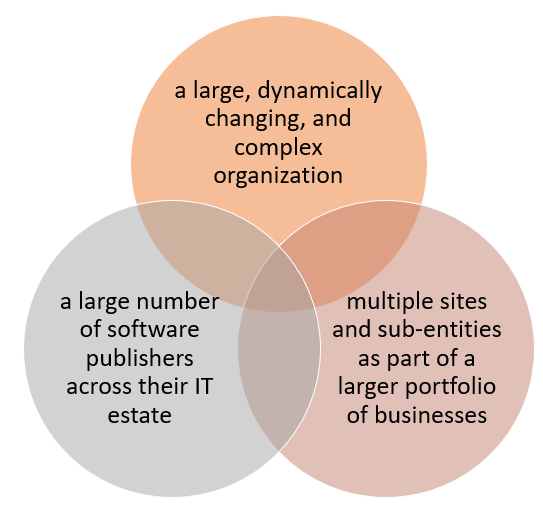IBM IASP – a new dawn for IBM licensing compliance?
IBM have announced a new, nicer, approach to license compliance – via the IBM Authorized SAM Provider Offering (IASP).

What is IASP?
Well, if you search online, the internet will tell you it is an “independent auxillary storage pool” – made by IBM. It seems we’ve got to the stage where vendors are running out of acronyms!
In ITAM terms, IASP is actually a “new” approach to compliance – an alternative to traditional software license reviews. Headed up by Sanjay K Saxena, the program is run with 4 Authorized SAM Partners (ASPs) who work with customers to manage their environment proactively.
The stated objectives of IASP include:
- Introduce and enhance SAM processes and benefits
- Enable proactive IBM management
- Provide greater assurance of compliance
- Facilitate transition to hybrid cloud
Who is it for?
Currently an invitation only programme, IBM are looking for customers who have:

If you feel you fit this description, it may well be worth talking to your IBM contacts to see how to get an invitation.
What does the partner do
The SAM partner provides the specialist knowledge and skills needed to address challenges with IBM software management and compliance. This includes things like:
- ILMT installation & configuration
- Understanding entitlements
- Planning & optimization
- Completeness of inventory
- Reporting on S&S reductions, consolidations etc.
How does it work?
That can be summed up in this handy graphic:

* It’s to be noted that IBM state “certain conditions may apply”.
Partners
There are just 4 partners able to deliver IASP engagements:
- KPMG
- Deloitte
- EY
- AnglePoint
Sanjay K. Saxena, Worldwide Director of the IASP program, said this is a conscious decision to “ensure that customers see it as an impartial review” and that isn’t always the case when licensing resellers are also conducting SAM engagements.
Organisations will contract with the IASP partner directly, meaning pricing and services are in the hands of the IASP, not funded by IBM.
What are the benefits?
IBM see that having access to specialised skills around IBM licensing and ILMT as a major benefit, as well as the peace of mind that comes with knowing there’s one less potential audit on the table. They are also positioning it as an optimisation tool that can help customers identify areas of over-deployment, incorrect metrics, and maximise the use of agreement benefits. I believe organisations that currently use Flexera in place of ILMT will be able to continue to do so under IASP.
Commercial Benefits
This is where the IASP program could make a real difference for organisations as IBM are willing to forgo some of their usual penalties around license non-compliance. For customers in the IASP program, IBM will allow them to purchase shortfall licenses at their regular discounts AND waive the usual back-maintenance requirement. Plus, according to this Anglepoint page, there will be no full-capacity charges regardless of historical ILMT status.
How did this come about?
Saxena mentioned that parts of the industry have gone “off-piste” when it comes to audits, with them becoming too punitive and that audits are, by their very nature, “disruptive”. This, coupled with organisations feeling that vendors aren’t doing much/enough/anything to help them remain compliant, has led to a lot of ill-feeling across customers.
Over the last 5 years, Saxena has met with “100s of customers” around the world to better understand why they’re dissatisfied and what IBM can do to turn that around; all this information has, and will continue to, feed into the design of IASP program. He said the “genesis of IBM IASP is client satisfaction” and that their aim with IASP is to create “truly delighted clients”. IBM say they will continue to meet with, and understand the challenges of, customers around the world to keep improving their program.
This sounds familiar…
That’s because you’ve heard it before – from Microsoft. Their SAM Managed Service program, introduced in 2017, had very similar aims and used very similar methods and strategy. The benefits from Microsoft include:
- The “Fresh Start” program regarding historical compliance
- A reduced risk of Audit
- Technology roadmap discussions
- Cloud, Cyber Security, and/or other value-based consultations
- Review of end of life products
And, as I said in my article at the time, it appeared to be a real paradigm shift for Microsoft SAM. Whether customers in the programme have found that to be the case, I’m not so sure. I do know that Microsoft’s overall SAM strategy is now looking very focused on migrating workloads into the cloud – https://marketplace.itassetmanagement.net/2019/07/26/microsoft-abusing-sam/.
…but I don’t think it is
Having spoken further to Sanjay K. Saxena, there doesn’t seem to be the same, strong, almost all-encompassing desire to move customers to the cloud, as there can be with other vendors. Perhaps this is indicative of where IBM’s focus, and revenues, still sit – primarily with their middleware products.
Conclusion
From speaking with Saxena, this appears to be a genuine attempt to make SAM easier for (some of) their clients.
Of course, helping customers streamline their IBM environment, reducing technical debt, migrating to modern metrics, removing the worry about historic ILMT charges etc. will make any move to cloud much smoother – but, to quote Saxena, this is:
“Not a vehicle to another destination, but a vehicle to help customers feel even better about using IBM software”
The fact that IBM don’t fund the engagements is interesting too – meaning, in theory, the IASP partner works for the client, not the vendor.
However, if you’re invited to join the IASP program, I’d still think carefully about your current situation and plans around IBM. What are your internal capabilities around IBM? Does it make sense to pay for a 3rd party to install and manage your ILMT environment? Do you need/want another 3rd party involved in your ITAM operations?
Be aware too, of where this invitation will be sent. Will they send it to you and await your reply, or will they meet with your CIO and talk about all the wonderful things that will happen, how you’ll digitally transform and save millions, and how everything will be nice and easy? If you think your organisation fits the bill for IASP, perhaps have a pre-emptive conversation internally to state your case before the vendor gets in touch.
That said, overall, I think this program could be beneficial for many organisations. It has a strong set of benefits – expert assistance with ILMT, no retrospective compliance charges, ability to fill gaps with current commercial terms, quarterly license positions – that all look very attractive and should help an IASP customer focus on more pro-active parts of their business. However, these must be balanced against things such as costs from the IASP partner, what is required to maintain compliant participation in the scheme, and how that fits into your workflow and plans.
It’s early days for the IASP program and all the details aren’t out there, so it’s hard to know for sure but, following my conversations with Saxena, I’m cautiously optimistic that the IBM IASP program is headed in the right direction.
Ps:
It’s not just Microsoft and IBM, the other half of the Big 4 software vendors are getting involved too.
Oracle
Oracle have a programme; “Software Investment Advisory” (SIA) which will, apparently, help you “learn how subscription and licensing options can improve value, from consolidating your Oracle investments across siloed operations to migrating assets to the cloud”.
SAP
While SAP’s “Digital Access Adoption Program” (DAAP) isn’t quite the same thing, it does also have the more friendly vibe of their competitors. SAP have said that DAAP “will ensure that no customer will be penalized for violating license rules in the past” and “SAP has no desire to declare our customers to be “out of compliance”, but rather to partner with our customers on a journey of digital transformation”.
Further Reading
KPMG on-demand webinar – https://event.webcasts.com/viewer/event.jsp?ei=1256685&tp_key=66548dfe63
Anglepoint IASP page – https://www.anglepoint.com/iasp/
Oracle Software Investment Advisory – https://www.oracle.com/corporate/software-investment-advisory.html
SAP Digital Access Adoption Program – https://news.sap.com/2019/05/making-move-digital-access-adoption-program/
Related articles:
IBM IASP: The good, the bad, and the ugly
SAP Digital Access Adoption Program (DAAP) set to expire
IBM Virtualization; Five Hidden Costs
Flexera & IBM collaborate on hybrid IT governance
Red vs Blue, why Red Hat acquisition may revolutionise IBM
IBM auditors target compliance revenue per customer - Three strategies to tackle IBM software waste head-on
- Tags: IBM audit · IBM IASP · IBM Licensing · IBM licensing compliance · Oracle SIA · SAP DAAP
About Rich Gibbons
A Northerner renowned for his shirts, Rich is a big Hip-Hop head, and loves travel, football in general (specifically MUFC), baseball, Marvel, and reading as many books as possible. Finding ways to combine all of these with ITAM & software licensing is always fun!
Connect with Rich on Twitter or LinkedIn.

Interesting article, and very good to read that IBM is putting effort into making the audit process more constructive and customer-oriented.
In my view, there are 3 additional elements that might require additional context and focus:
(1) One of the focus points of the IASP program is ILMT/BigFix. What is the approach if HCL starts putting its stamp on the ILMT/BigFix tool (and even reviews)? Will it remain a part of the IBM audit portfolio?
(2) How do you see end-users respond to the IASP program taking into account that only a limited amount of IASP partners are available? More specifically:
A. IBM seems to select 3 out of the traditional Big-4 firms, where it has a close relationship with given the past audit programs and mutual established ‘go-to’ market strategies. Will the aspect of ‘vendor-neutrality’ be obtained by just switching from a ‘time and material’ payment model (carried by IBM) to a model where a direct contract exists between the end-user and the IASP partner?
B. How does IBM handle cases where an end-user already has a (preferred) third-party in place for its IBM license management? Does this entail that an end-customer, which would like to become part of the IASP program, is forced to change its SAM/IBM partner?
This is v2 of the License Management Option (“LMO”) which was available as an option for all SSSO client but subsequently withdrawn by IBM due to lack of adoption.
The only difference is that this time the client has to pay for one of this “Authorised Partners” to do SAM because IBM don’t think you (customer) is capable of doing so.
I think in other words this is IBM trying to get customers to pay for their own audit fees – yes they get discounted price but we all know how much discounts customer gets in real life audit settlements so it isn’t a real advantage.
And since client is audited every quarter the back S&S charge shouldn’t even stand anyway.
I will keep my eyes open on how much the market welcomes this 😉
Hi Eric, did you have some more other experiences so far with IBM’s IASP program that are worthwhile to share with the bigger audience? Rgds, Ricahrd
[…] IBM IASP […]